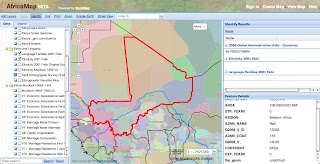This is my figure:
 As far as its features, style components, and aesthetic, it is difficult for to know where to start, as I have never done close examination of artistic artifacts before -- but here goes:
As far as its features, style components, and aesthetic, it is difficult for to know where to start, as I have never done close examination of artistic artifacts before -- but here goes:The figure appears to be carved wood. I would describe its features as detailed yet minimalist. The head and neck of the female figure are both enlarged and elongated; its torso is elongated and thin, and its hands are seemingly featureless. What appears to be a coiffure is textured with parallel lines. Its legs seem short and its hips wide, even as the figure appears to stand in a squatting position.
As far as the face goes, the nose and nasal ridge seem to protrude exceedingly. The figure appears to be sporting a nose ring. The eyes, though small, are distinguished as the only lighter-colored feature on the statuette.
The breasts and belly-button are conical, and while the breasts are proportionally small, the belly-button seems proportionally large. Both are adorned with convex dot-markings, which the Metropolitan Museum of Art explained could refer to “scarification marks once made to beautify adolescent Bamana women.”
An interesting feature is the v-shaped indentation between the legs, which seems to refer to something involving reproduction.
Two ankles and 1 wrist are adorned with red beaded bracelets, but it is hard to tell from looking at it how of from what these were fashioned. The wristband looks like it was tied with some sort of hemp-like string, and the beads appear to be painted wood, but I cannot be completely sure.
Overall, the figure seems very idealized. I look forward to finding more explanations about the various features.

Source:Female Figure [Bamana peoples; Mali] (1978.412.347) | Heilbrunn Timeline of Art History | The Metropolitan Museum of Art
- Art of the Bamana of Mali, by George A. Corbin
- Sculpture of the Bamana, by Kate Ezra
- The Bamana World, by Pascal James Imperato
- A Human Ideal in African Art: Bamana Figurative Sculpture, by Kate Ezra
- Bamana: The Art of Existence in Mali, ed. by Jean-Paul Colleyn

